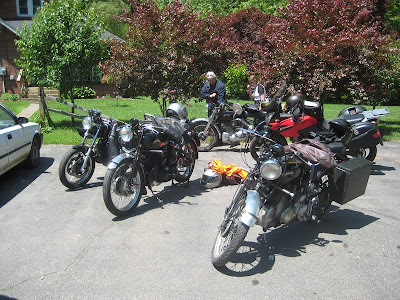 Large-capacity twin cylinder machines weren't the only bikes of choice on the rally, and several classic Singles made the rally with no problems. The big winner of the weekend was Kevin Burrell's '47 Velo MSS 500cc ohv, which was also one of the prettiest bikes on the ride, but I'm biased as it used to be mine! Kevin won the big King of the Melee trophy for making it look easy to ride a rigid-frame machine 900 miles in 3 days, plus a few bonus miles on the Lost Coast, on dirt roads.
Large-capacity twin cylinder machines weren't the only bikes of choice on the rally, and several classic Singles made the rally with no problems. The big winner of the weekend was Kevin Burrell's '47 Velo MSS 500cc ohv, which was also one of the prettiest bikes on the ride, but I'm biased as it used to be mine! Kevin won the big King of the Melee trophy for making it look easy to ride a rigid-frame machine 900 miles in 3 days, plus a few bonus miles on the Lost Coast, on dirt roads. 
Another interesting machine is Lyn Miller's Norton ES2 special, one of the rare non-Featherbed swingarm models with an all-alloy engine. It ran very well, and quickly.

The route on Day 2 incorporated the legendary Hwy 36, which is just about a perfect motorcycle road, stretching 72 miles from Red Bluff to the coast. But, we veered north midway to explore Forest Road 1 (above, with my Atlas and Frank Forster's ultra-dependable Commando tourer), which is the longest continuous 'ridge road' in the world - it follows a spur of the Coastal Range for almost 80 miles, and for long stretches the road itself IS the top of the ridge - a fall in either direction will land you in one or another valley - to the West one can see the fog lurking over the Pacific, to the East shone the snowy peaks of Mt. Lassen. FR1 climbs to about 5500' at points, and is blissfully cool during the day, with a showy array of wildflowers carpeting the dozens of small meadows bordering the road. One lane wide, no stripes, no traffic at all.

Our lunch stop was the Samoa Cookhouse, a historic building which formerly served as the canteen numerous lumber mills and shipping companies which populated this strangely-named town. The cookhouse serves the same food, in the same manner, as it always has; you get what you get, as much of it as you want, whatever they're serving that day. If you come away hungry, it's your own fault! Photos of the days when lumber was king in Arcata/Eureka line the walls, as do some of the implements of logging.

Lumber was Very Good to the burghers of Eureka, and quite a few splendid examples of High Victorian mansions survive as museums or private clubs.

But, they didn't get ALL the old-growth Redwoods, and the Avenue of the Giants is one of two large stands of these ancient behemoths untouched by the saw. For 50 miles the road threads between the tallest trees in the world, and the light filtering through the high canopy feels like the interior of a Gothic cathedral. But, we get to ride through this church, and commune with any god we choose.

The ride on Sunday totaled 340 miles, and it was a relief to arrive at our Motel, even after a nice cool stretch of Highway 1 along the ocean cliffs. As beautiful as the road is, I was ready for a shower, a meal, and a drink. Smiles prevailed at the greeting point, where your room key and a cold beer awaited (below, Phillippe Murat is happy about his beer).

A few souls had the energy to fettle, even after a long day in the saddle, on a scooter! These guys really impressed me.


By the next morning, the carnage of the weekend had become clear; all 3 chase vehicles were full, and help arrived from a local collector. A few of the machines were hors de combat, like this Triumph which has clearly had a Serious Problem with a connecting rod... ouch.

A sad fate for a BSA Gold Star and Velocette Thruxton - racing each other in the back of a pickup truck! Being chased as usual by a BSA Hornet and Triumph Bonneville, in the trailer.

As mentioned, the range of machines was dramatic, and included a multi-year veteran Lambretta (in purple, to match Barry's hair!) and this first-time '38 Indian Chief, which had a little trouble with a duff battery.
 If you have an interest in joining next year, you can find more information on the Moto Melee website; the date is typically the third weekend in June, Friday thru Monday. You'll never forget the ride.
If you have an interest in joining next year, you can find more information on the Moto Melee website; the date is typically the third weekend in June, Friday thru Monday. You'll never forget the ride.For more Melee photos, check out:
Bob Slote's Flickr page
Craig Howell's photos
Blaise Descollange's photos






























